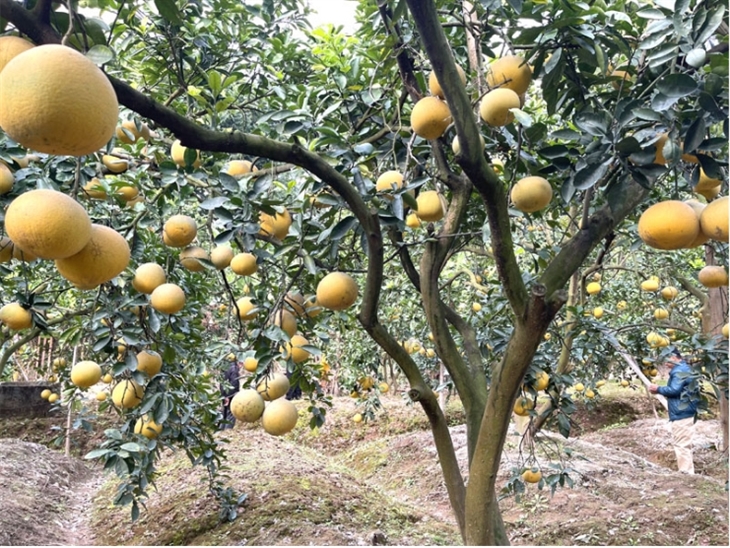Opportunity to export grapefruit when Australia completes assessment
Monday, May 26,2025
AsemconnectVietnam - Australia has just completed a risk assessment for Vietnamese grapefruit, opening up great opportunities for exporting grapefruit products to this market.
Vietnam National Sanitation and Plant Quarantine Information and Enquiry Point (Vietnam SPS Office) under Ministry of Agriculture and Environment said that the Australian Department of Agriculture, Fisheries and Forestry (DAFF) has just officially issued the "Final Report on Biosafety Requirements for Fresh Grapefruit Imported from Vietnam".
The report shows that Australia has completed a risk assessment of the entire production, harvesting, post-harvest handling and transportation of grapefruit from all commercial production areas in Vietnam.
Through analysis, DAFF identified 19 pests that require risk management measures to ensure biosecurity. Notably, these include the Asian citrus psyllid (Diaphorina citri), the oriental fruit fly (Bactrocera dorsalis), mealybugs and red spider mites, which have affected citrus products in many countries.
To meet the requirements of protecting the ecosystem and indigenous agriculture, Australia proposes control measures including: Pest-Free Planting Areas or Production Facilities (PFA), treatment with irradiation or Methyl bromide and visual inspection before export.
For citrus canker, Australia requires application of a “Systemic Approach”, including a series of integrated measures from the orchard to post-harvest treatment.
Assessment does not stop at technical aspect. Australia said that it had consulted with 7 domestic and foreign organizations and individuals before completing the final report. Adjustments to production information, pest management and new data updates are all reflected in the April 2025 report.
Notably, Australian quarantine agency emphasized that 3 species on the above list, such as red spider and mealybug, are subject to regional quarantine in Western Australia. Therefore, although imported into the Australian market, grapefruit products still need to comply with additional regulations when transported between states.
Mr. Ngo Xuan Nam - Deputy Director of Vietnam SPS Office - said that Australia's recognition of Vietnam's ability to meet biosafety standards opens up great opportunities for Vietnamese grapefruit.
Completion of this report not only marks a step forward in market opening negotiations but also demonstrates the increasingly improved capacity of Vietnam's crop and plant protection sector in meeting high international biosafety requirements.
According to the plan, after the report is published, Australia will conduct final verification steps with Vietnam to ensure capacity to implement quarantine measures. When completed, official import conditions will be announced on Australia's BICON system - information portal regulating the import of plants and plant products.
Up to now, Vietnamese grapefruit has been officially licensed for export to 13 countries and territories. Of which, Chinese market accounts for more than 50% of total export turnover. The next largest markets are the United States and South Korea. In addition, Vietnamese grapefruit has appeared in markets such as Canada, New Zealand, Germany, the Netherlands, UAE, Hong Kong (China) and Norway.
Source: Vitic/ congthuong.vn
The report shows that Australia has completed a risk assessment of the entire production, harvesting, post-harvest handling and transportation of grapefruit from all commercial production areas in Vietnam.
Through analysis, DAFF identified 19 pests that require risk management measures to ensure biosecurity. Notably, these include the Asian citrus psyllid (Diaphorina citri), the oriental fruit fly (Bactrocera dorsalis), mealybugs and red spider mites, which have affected citrus products in many countries.
To meet the requirements of protecting the ecosystem and indigenous agriculture, Australia proposes control measures including: Pest-Free Planting Areas or Production Facilities (PFA), treatment with irradiation or Methyl bromide and visual inspection before export.
For citrus canker, Australia requires application of a “Systemic Approach”, including a series of integrated measures from the orchard to post-harvest treatment.
Assessment does not stop at technical aspect. Australia said that it had consulted with 7 domestic and foreign organizations and individuals before completing the final report. Adjustments to production information, pest management and new data updates are all reflected in the April 2025 report.
Notably, Australian quarantine agency emphasized that 3 species on the above list, such as red spider and mealybug, are subject to regional quarantine in Western Australia. Therefore, although imported into the Australian market, grapefruit products still need to comply with additional regulations when transported between states.
Mr. Ngo Xuan Nam - Deputy Director of Vietnam SPS Office - said that Australia's recognition of Vietnam's ability to meet biosafety standards opens up great opportunities for Vietnamese grapefruit.
Completion of this report not only marks a step forward in market opening negotiations but also demonstrates the increasingly improved capacity of Vietnam's crop and plant protection sector in meeting high international biosafety requirements.
According to the plan, after the report is published, Australia will conduct final verification steps with Vietnam to ensure capacity to implement quarantine measures. When completed, official import conditions will be announced on Australia's BICON system - information portal regulating the import of plants and plant products.
Up to now, Vietnamese grapefruit has been officially licensed for export to 13 countries and territories. Of which, Chinese market accounts for more than 50% of total export turnover. The next largest markets are the United States and South Korea. In addition, Vietnamese grapefruit has appeared in markets such as Canada, New Zealand, Germany, the Netherlands, UAE, Hong Kong (China) and Norway.
Source: Vitic/ congthuong.vn
Vietnam's wheat import markets in first four months of 2025
Vietnam's corn imports in 4 months of 2025
Agricultural, forestry and fishery exports grow steadily
Import and export: A leap forward after more than two decades
Vietnam - Thailand Trade: Driving Force from 'Three Connections'
Tariff quotas expected for rice and dried tobacco from Cambodia
Fertilizer export markets in first 4 months of 2025
Record rice exports: When seeds are the key
Vietnam's fertilizer imports see significant growth in early 2025
Export tax rate on cement and clinker to be reduced
Organic products only account for about 1.46% of export turnover
Bird's nest exports have more competitors in China
Durian exports: Accelerating to maintain market
Exports to Germany increased in 4 months of 2025


